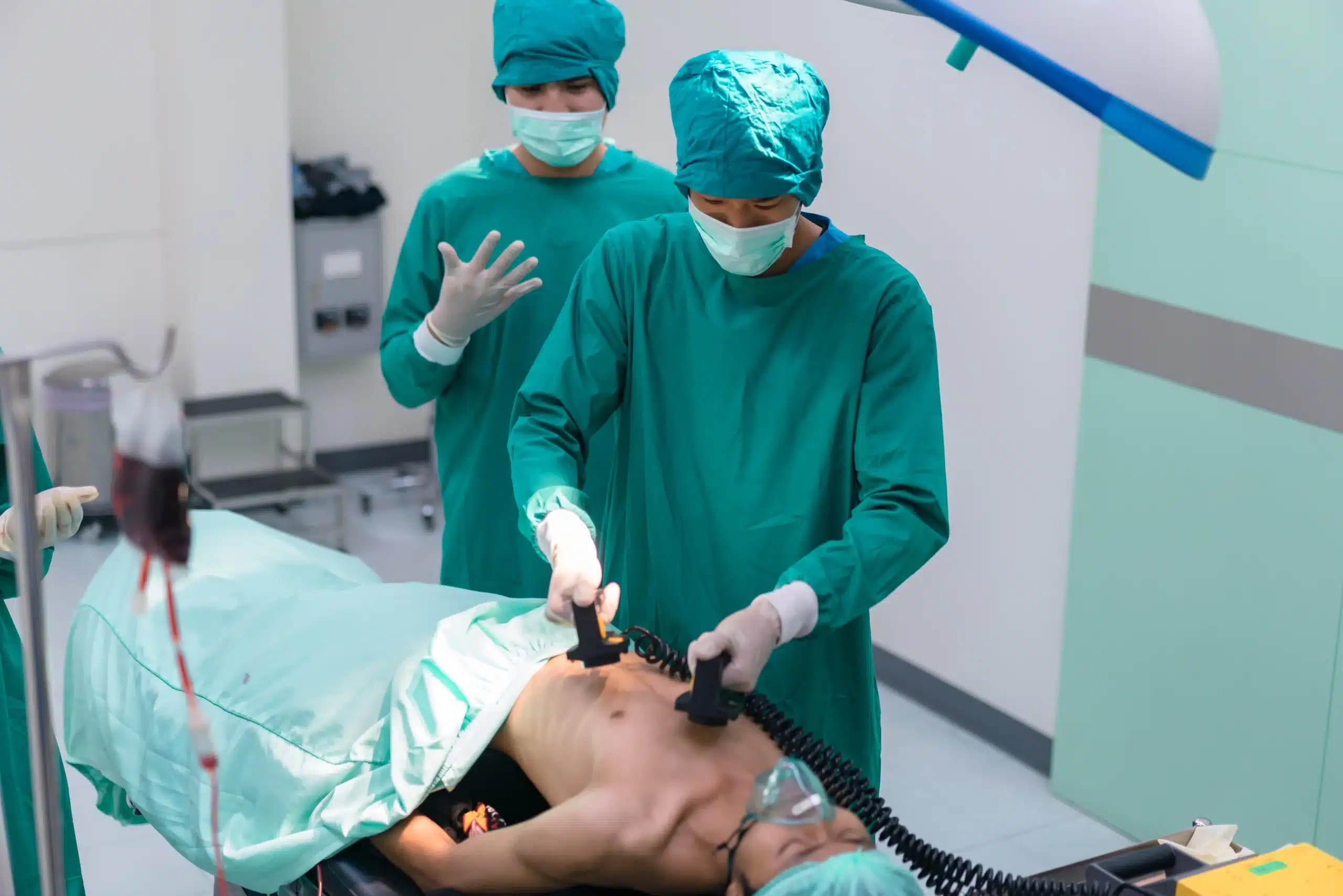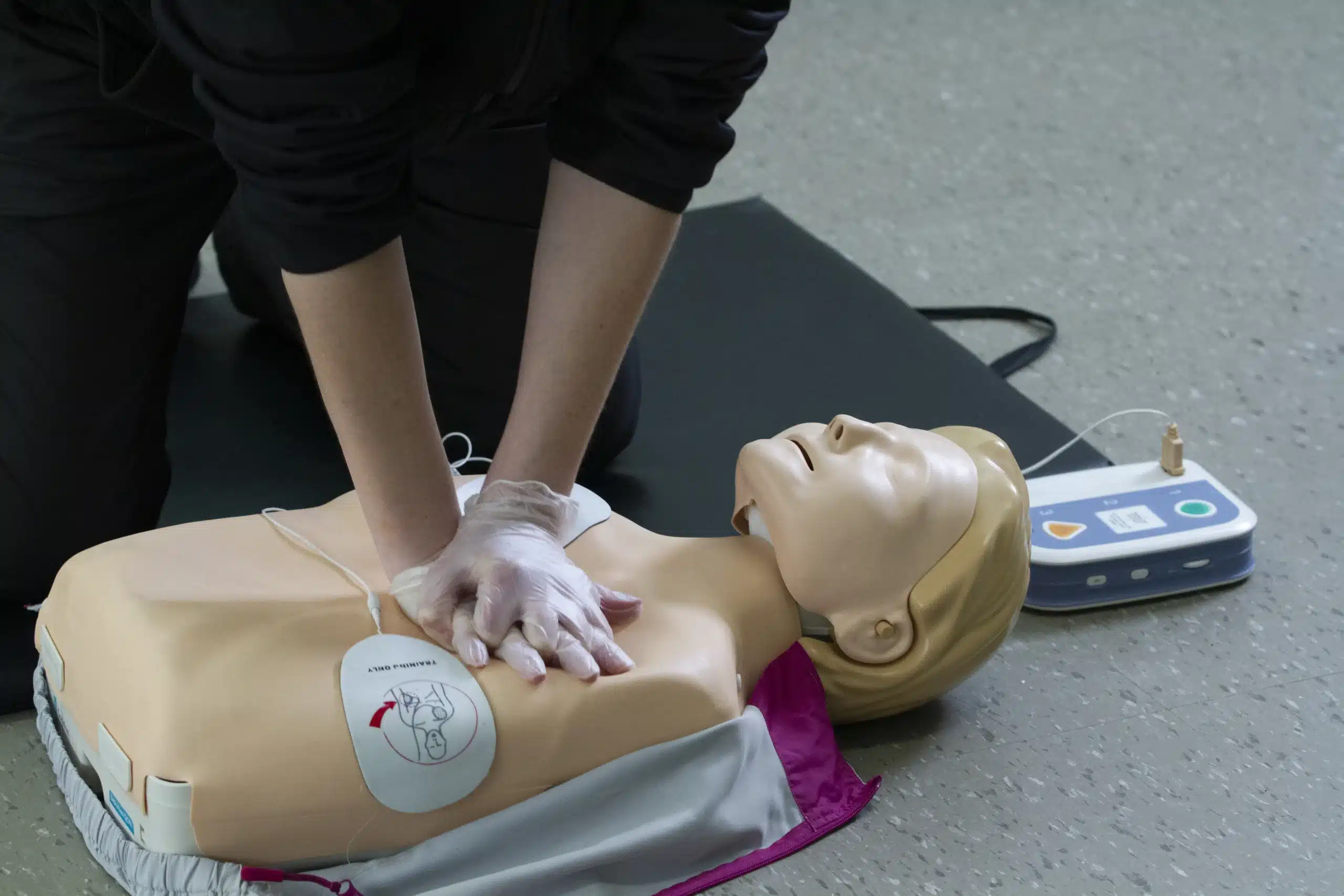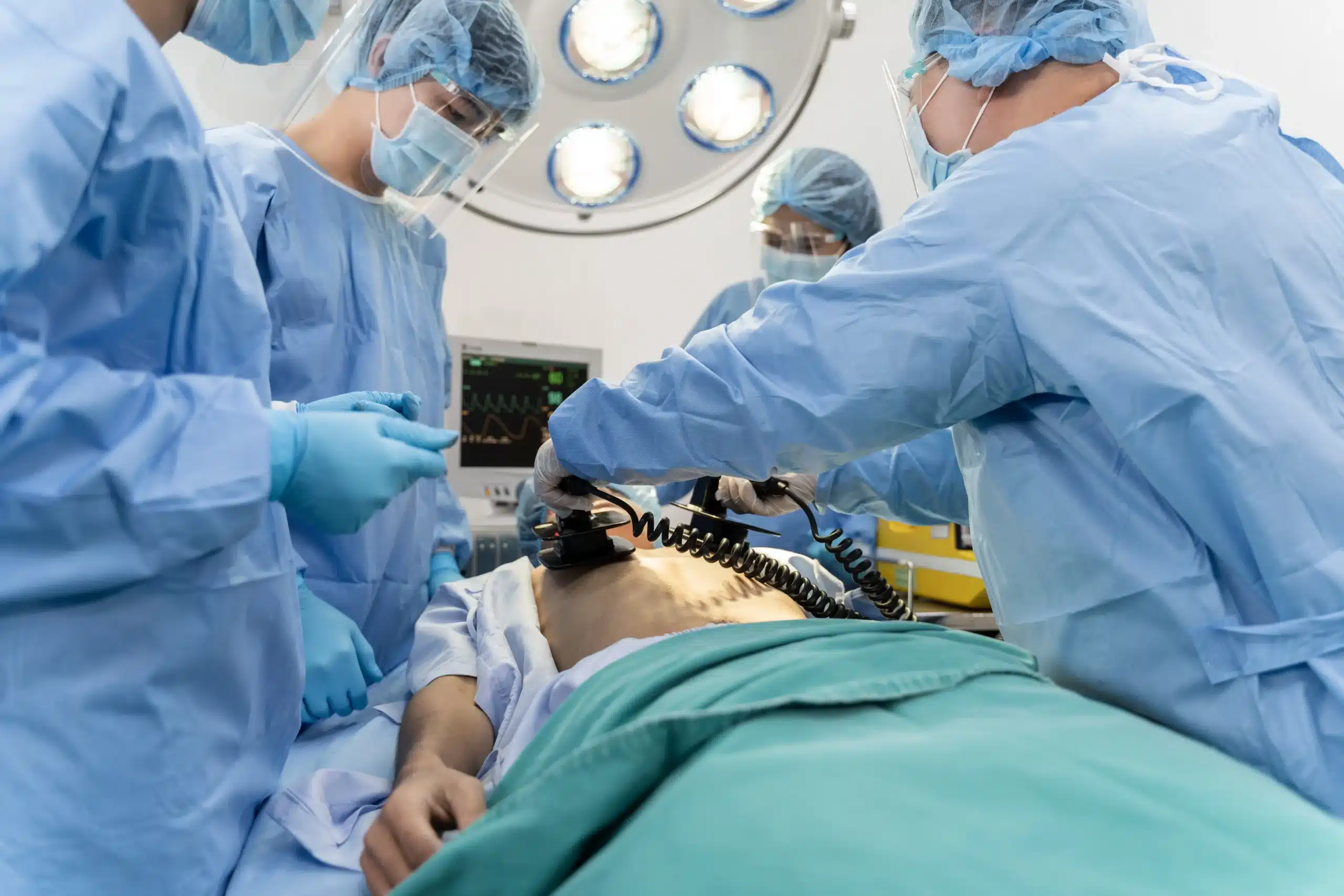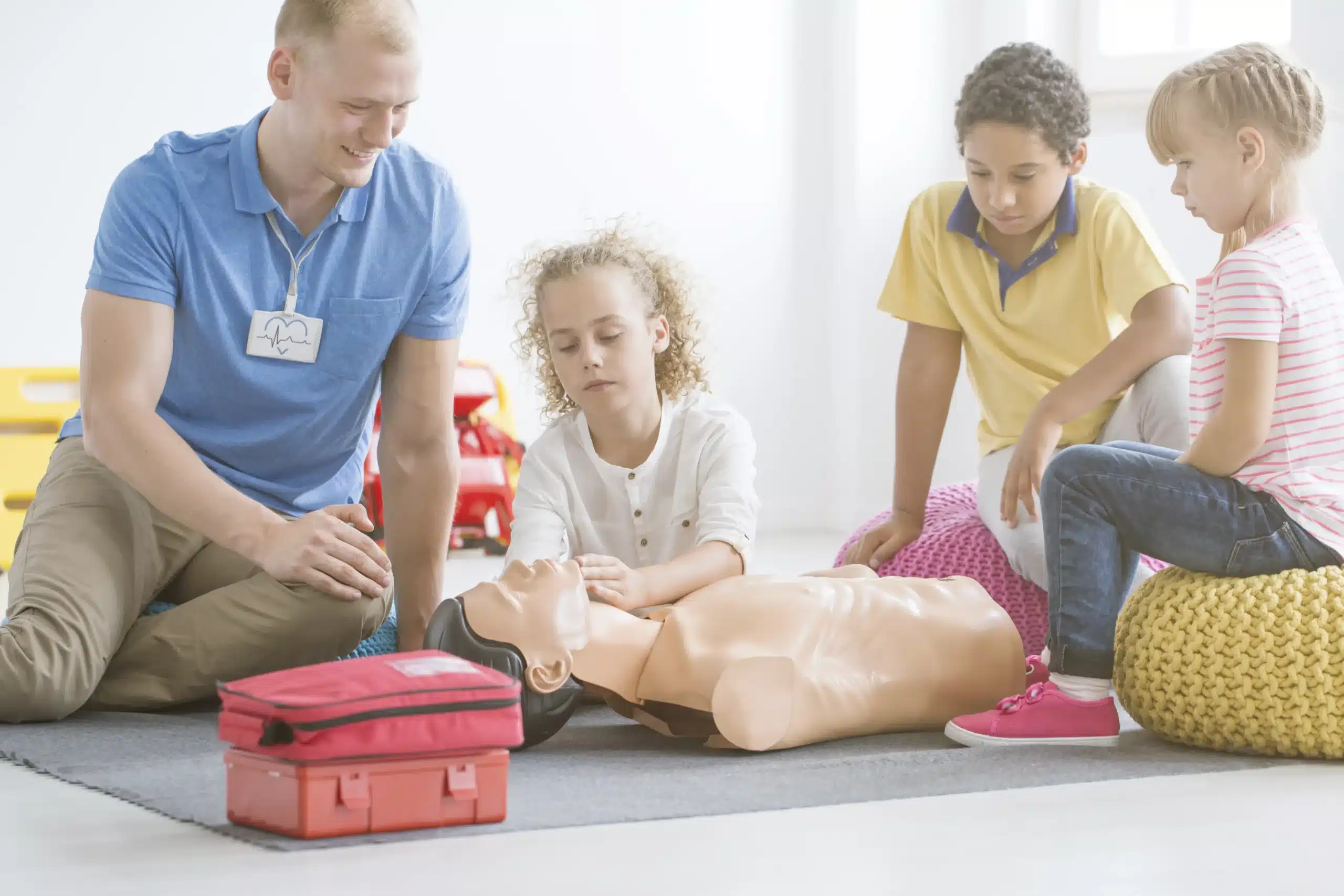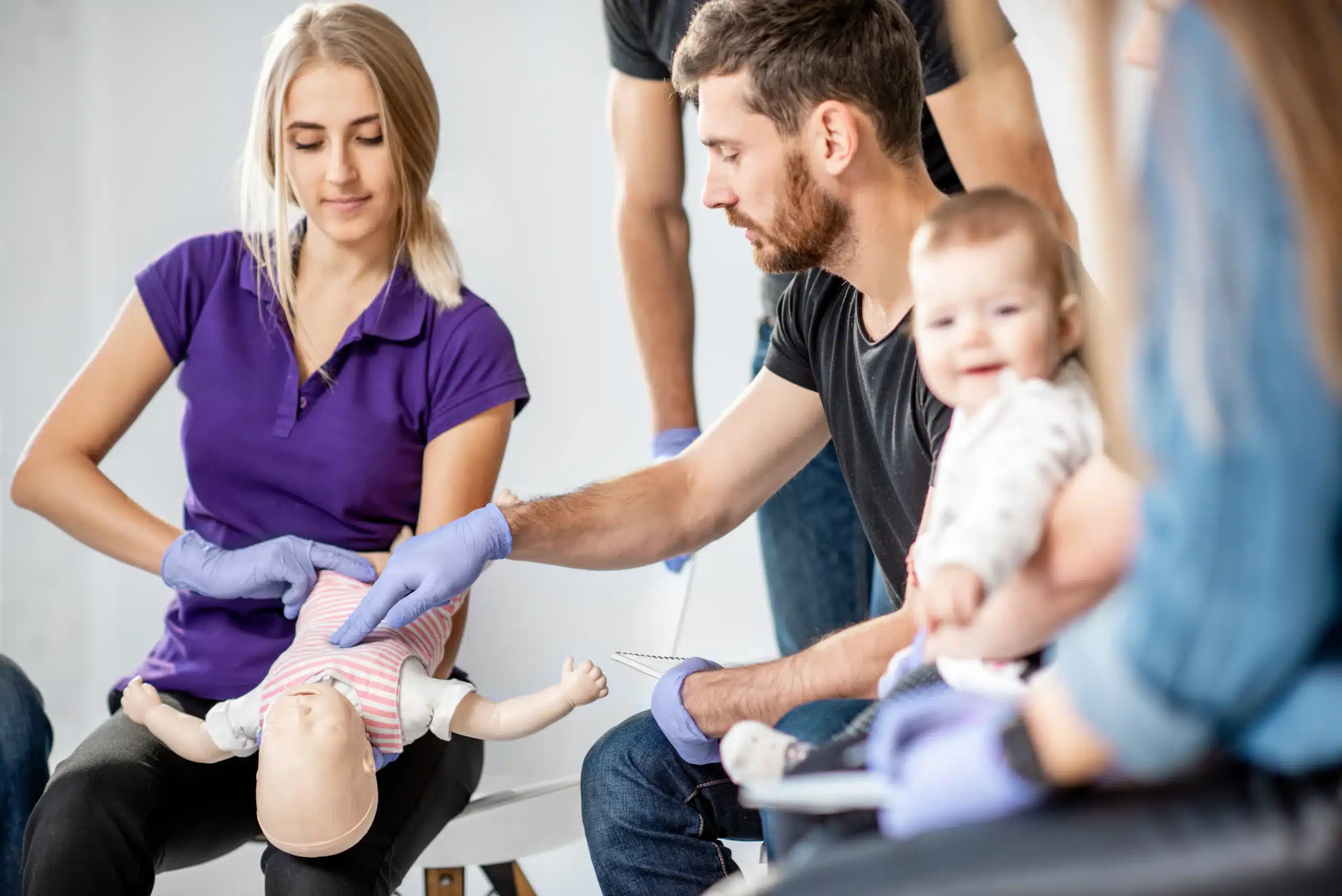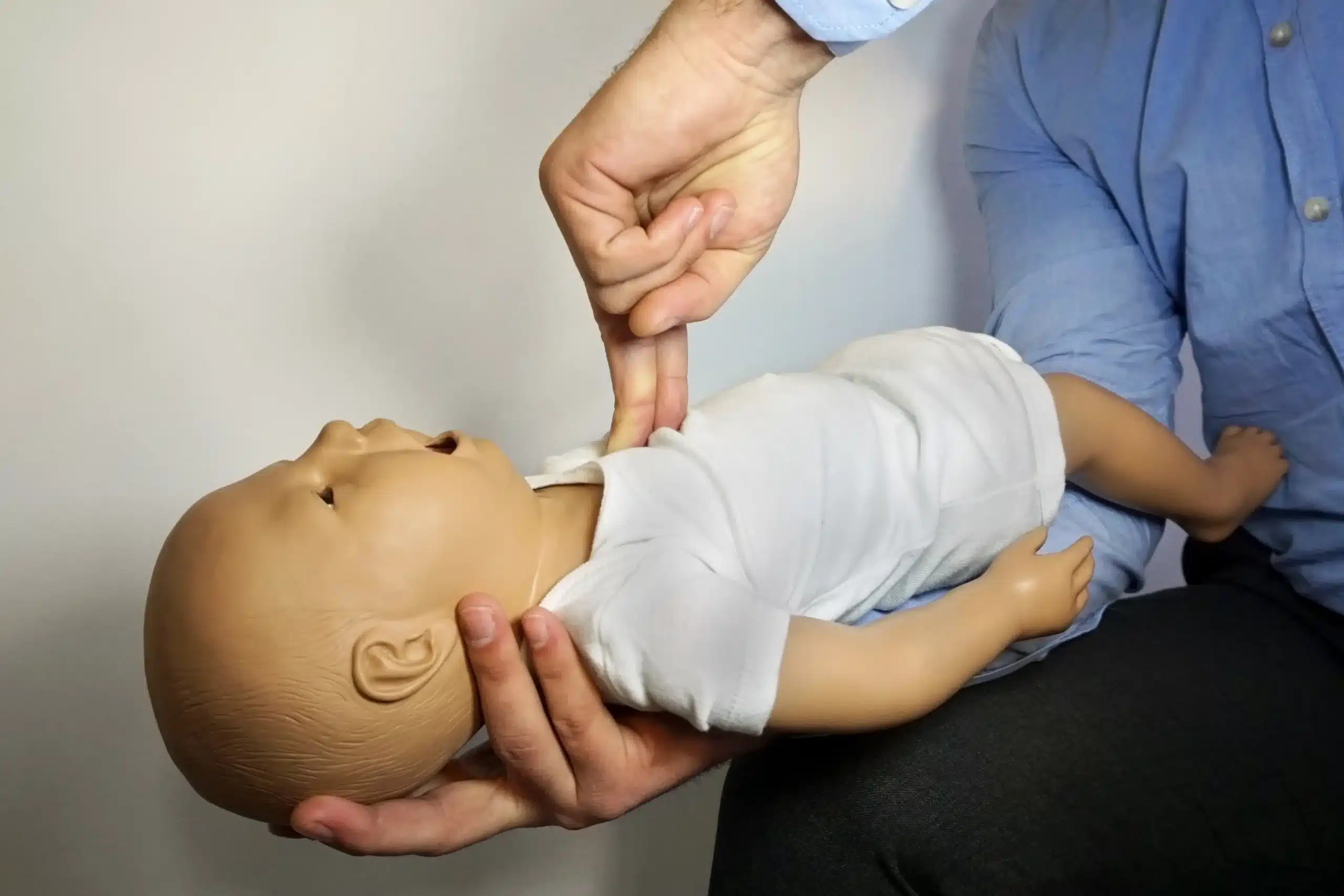In times of crisis, seconds can matter. BLS certification equips you with the knowledge and skills to respond effectively in medical emergencies, providing crucial care until more advanced help arrives. This certification is not just for healthcare professionals; it’s a valuable asset for anyone who wants to be prepared for the unexpected. This guide breaks down the essentials of BLS certification, including key skills, who benefits from training, and how to find BLS certification nearby. We’ll also explore different training formats, costs, and top providers to help you choose the best path for your needs.
Key Takeaways
- BLS certification equips you with essential life-saving skills. Learn CPR, AED use, and choking relief for all ages, enabling you to confidently respond to medical emergencies and provide immediate care.
- Affordable and convenient BLS training is readily available. Explore local training centers, online platforms, and blended learning options to find a course that fits your schedule and budget. Consider San Ramon CPR Courses for convenient, local training.
- Maintaining your BLS skills is crucial for long-term preparedness. Stay up-to-date with the latest guidelines, renew your certification regularly, and practice your skills to ensure you’re always ready to respond effectively in a crisis.
What is BLS Certification & Why Do You Need It?
BLS certification, or Basic Life Support certification, equips you with the skills to respond to life-threatening emergencies. It’s the foundation for healthcare professionals and anyone wanting to provide immediate care in critical situations. Think of it as the essential first step, providing crucial aid before more advanced medical help arrives. BLS training emphasizes early intervention, focusing on the most effective techniques to maintain life and prevent further harm. This proactive approach can dramatically improve outcomes in emergencies.
Key BLS Skills
BLS covers a range of life-saving techniques applicable to various emergencies. Core skills include CPR for adults, children, and infants, addressing different physiological needs. You’ll also learn how to handle choking incidents for all ages, a common yet potentially dangerous situation. BLS training also covers the proper use of an AED (Automated External Defibrillator), a device that can restore a normal heart rhythm. Finally, the use of breathing barriers is emphasized to protect both the rescuer and the patient. These skills combined create a comprehensive approach to emergency care. For more information on CPR training and certification, visit San Ramon CPR Courses.
Who Needs BLS Certification?
BLS certification is often a requirement for many healthcare professions. Most US medical facilities require their nurses to hold a current BLS certification, and some nursing schools even make it a prerequisite for admission. Beyond nurses, it’s highly recommended for anyone working in a healthcare setting, even in non-direct patient care roles. Doctors, medical assistants, therapists, and other healthcare providers all benefit from having these essential skills. Beyond the medical field, BLS certification is valuable for childcare providers, teachers, coaches, lifeguards, and anyone responsible for the safety of others. Having these skills can make a profound difference in someone’s life. If you’re in the San Ramon, Dublin, or Danville area, check out the range of courses offered by San Ramon CPR Courses. They offer a variety of options to fit your needs and schedule.
Find BLS Certification Classes Near You
Finding the right BLS certification course starts with understanding what options are available and which best suits your needs. Let’s explore the most common paths to finding BLS training.
Local Training Centers & Organizations
Local training centers offer in-person BLS classes, providing hands-on learning and direct interaction with instructors. This format is ideal for those who thrive in a traditional classroom setting and value face-to-face guidance. Many hospitals, community colleges, and dedicated CPR training centers offer these courses. Check with your local fire department or community center for recommendations on reputable training centers in your area. For example, Fairfield CPR Classes offers a range of American Heart Association courses, including BLS.
Online BLS Certification Platforms
Online BLS courses have become a popular and reliable solution, offering the flexibility to complete training from anywhere with internet access. This format is particularly convenient for busy professionals or those with scheduling challenges. Many reputable organizations, including the American Heart Association, offer online BLS courses that meet the same rigorous standards as classroom-based training. These courses often involve a combination of online modules, videos, and virtual simulations to ensure you gain the necessary knowledge and skills. You can find more information on online BLS courses from sources like Bragging Mommy.
San Ramon CPR Courses: Your Local BLS Provider
If you’re in the San Ramon, Dublin, or Danville area, San Ramon CPR Courses is your local provider for high-quality, affordable BLS certification. We offer a convenient location at Bishop Ranch 1 and provide certification cards upon successful completion of the course. Our courses are designed to equip you with the skills and confidence to respond effectively in emergency situations. We also offer group discounts, making it a cost-effective option for workplaces or groups of friends. For more information about our CPR and First Aid certification courses, visit our CPR and First Aid page. We also offer RQI classes and EMSA Child Care Health & Safety training. Don’t forget to check out our low price guarantee.
Choose the Right BLS Training Format
Deciding on the right BLS training format depends on your learning style, schedule, and preferences. Let’s break down the most common options: in-person, online, and blended learning. Each has its own advantages, so consider what works best for you.
In-Person Training: Hands-on Experience
In-person BLS training offers a structured learning environment with direct interaction with instructors. This format is ideal for those who value hands-on learning and thrive in a classroom setting. You’ll get real-time feedback on your technique and have the opportunity to practice skills with other students. This face-to-face instruction can be especially helpful for mastering essential techniques like CPR and using an AED. For personalized instruction and immediate feedback, consider checking out local training centers, like San Ramon CPR Courses.
Online Certification: Flexibility and Convenience
Online BLS certification courses provide a flexible alternative to traditional classroom training. If you have a busy schedule or prefer learning at your own pace, online courses can be a great fit. You can access the course materials anytime, anywhere, making it easier to fit into your life. Many reputable organizations, including the American Heart Association, offer online BLS courses that meet the same rigorous standards as in-person training. Just be sure to choose a program that includes a hands-on skills assessment component to ensure you’re fully prepared. For a convenient way to get certified, explore the rise of online BLS courses.
Blended Learning
Blended learning combines the flexibility of online learning with the hands-on practice of in-person training. In this format, you’ll typically complete the cognitive portion of the course online, then attend an in-person skills session to demonstrate your proficiency. This approach offers a good balance for those who want the convenience of online learning but also recognize the importance of hands-on practice. If you’re looking for flexibility without sacrificing practical experience, blended learning might be the perfect solution.
Understand BLS Certification Costs
Getting BLS certified is an investment in your skills and ability to respond to emergencies. Let’s break down the typical costs associated with BLS certification and explore ways to find affordable options.
Typical BLS Course Prices
BLS course prices vary based on several factors, including the training provider, course format (online or in-person), and your location. Many online BLS courses offer competitive pricing, sometimes with a one-time fee of around $25, or even less after passing the certification test. Some providers, like the National CPR Foundation, offer the BLS for Healthcare Providers certification for $14.95. This covers essential life-saving skills like CPR and AED use. In-person courses may have slightly higher prices due to the costs associated with classroom facilities, equipment, and instructor fees.
Discounts and Promotions
Look for discounts and promotions to save on BLS certification. Websites like American BLS often compile promo codes for CPR and BLS courses, which can significantly reduce the overall cost. Also, check if organizations like the American Red Cross are running promotions on training supplies or certification courses.
San Ramon CPR Courses: Affordable Options & Group Discounts
If you’re in the San Ramon, Dublin, or Danville area, San Ramon CPR Courses offers a range of affordable BLS certification courses. We’re committed to providing convenient and cost-effective training. We also offer group discounts for businesses, organizations, or groups of friends looking to get certified together. Contact us to learn more about our competitive pricing and our low price guarantee.
Evaluate BLS Certification Providers
Choosing the right BLS certification provider is crucial for a valuable and recognized credential. Here’s what to look for:
Accreditation & Industry Recognition
First, confirm the course is accredited by a respected organization like the American Heart Association (AHA) or the American Red Cross. These organizations uphold industry standards, ensuring your training aligns with best practices. AHA-accredited providers offer evidence-based training and updated guidelines, giving you confidence in the quality of your BLS certification. This accreditation also boosts your certification’s credibility with potential employers.
Instructor Qualifications & Course Content
Look for instructors with extensive experience and up-to-date knowledge. In-person classes offer hands-on learning and direct interaction with instructors, allowing for personalized feedback and guidance. Relevant course content is also key. Ensure the curriculum covers essential BLS skills, including CPR, AED use, and airway management, and aligns with your specific professional needs. For example, if you’re a nurse, a course designed by nurses ensures practical, real-world applicability.
Certification Validity & Employer Acceptance
Not all online BLS certifications are universally accepted. Verify your chosen provider offers certifications recognized by employers in your field. A valid certification from an accredited provider protects you from issues with certification acceptance down the line. This is especially important in healthcare settings where up-to-date BLS certification is often a mandatory requirement. Check with your employer or licensing board to confirm their accepted certifications.
Get BLS Certified: The Process
Getting your BLS certification is straightforward. This section breaks down the process into manageable steps, from prerequisites to receiving your card.
Course Prerequisites & Duration
BLS courses are designed to be accessible to a wide range of people. Typically, there aren’t any strict prerequisites for taking a BLS course. However, BLS training is essential for healthcare providers, and maintaining your certification demonstrates your commitment to providing high-quality care. Make sure the course you choose meets the requirements of your profession and licensing board. Most BLS courses last between four and six hours, including classroom instruction and hands-on practice. San Ramon CPR Courses offers a variety of course times to fit your schedule.
Skills Assessments & Exams
BLS certification courses require hands-on activity, so prepare yourself to practice chest compressions and other skills. You’ll learn how to perform CPR, use an AED, and relieve choking. Instructors will assess your skills throughout the course to ensure you’re performing them correctly. You’ll typically take a written exam at the end of the course to test your knowledge of BLS principles and procedures. Check with your chosen provider, like San Ramon CPR Courses, for specifics on their assessment process.
Receiving Your BLS Certification
After successfully completing the course and exam, you’ll receive your BLS certification card. Some providers issue physical cards, while others offer digital certificates. This card is proof of your BLS qualification and is valid for two years. Keep your certification current to maintain your credentials and demonstrate your commitment to patient care. San Ramon CPR Courses often has promotions and discounts available, making it even easier to get certified.
Maintain Your BLS Certification
Once you’ve earned your BLS certification, staying current is key. Knowing the renewal process, keeping up with the latest guidelines, and continuously practicing your skills will ensure you’re always prepared for an emergency. This ongoing commitment not only benefits your own professional development but also reinforces the high standard of care you provide.
Renewal Requirements
BLS certification, like many healthcare certifications, isn’t a one-time achievement. It requires renewal to ensure your skills and knowledge remain sharp. Generally, BLS certification is valid for two years. Understanding these recertification requirements and planning ahead helps you avoid any last-minute scramble. Mark your renewal date on your calendar and explore convenient online renewal courses as they become available. Online BLS courses offer flexibility, allowing you to complete the training from anywhere with internet access.
Stay Current with BLS Guidelines
Emergency care procedures and best practices are constantly evolving. Staying updated on the latest BLS guidelines is crucial for providing effective care. Regularly reviewing updated materials and seeking out continuing education opportunities will ensure you’re always aligned with the most current recommendations. This commitment to staying informed demonstrates your dedication to providing the highest quality care.
Continuous Skills Development
Beyond meeting the minimum requirements for recertification, continuous skills development is essential for maintaining proficiency in BLS. Regularly practicing your skills, even outside of a formal course setting, helps build muscle memory and confidence. Consider joining refresher workshops or practicing with colleagues to reinforce your skills and stay sharp. Continuous BLS skills development is crucial for maintaining proficiency and readiness for real-world emergencies. This proactive approach ensures you’re always prepared to respond effectively in critical situations.
BLS for Different Professions
BLS certification, or Basic Life Support certification, equips individuals with the skills to respond effectively to life-threatening emergencies. While often associated with healthcare, its importance spans various professions. Let’s explore how
Healthcare Providers & First Responders
BLS certification is fundamental for healthcare providers like doctors, nurses, paramedics, and EMTs. These professionals regularly encounter situations requiring immediate intervention, from cardiac arrest and respiratory distress to choking and other medical crises. Solid BLS skills are crucial for maintaining patient care and safety in hospitals, clinics, and emergency settings. BLS training emphasizes early recognition and response, ensuring healthcare providers can deliver timely and appropriate care, potentially saving lives. Maintaining your BLS certification demonstrates a commitment to providing high-quality care and staying up-to-date with the latest life-saving techniques. For more information on BLS recertification, check out our partners’ guide on recertification.
Childcare Professionals & Educators
For those working with children, BLS certification is just as vital. Childcare providers, educators, camp counselors, and nannies must be prepared to handle emergencies involving children, which can differ significantly from adult emergencies. BLS training provides these professionals with age-specific techniques for CPR, airway management, and choking relief. It empowers them to respond confidently and effectively in critical situations, ensuring the safety and well-being of the children in their care. Understanding basic airway management and how to assist a choking child are essential skills covered in BLS certification, making it invaluable for anyone working with young children. To learn more about common misconceptions surrounding BLS training, check out this helpful article on BLS.
Other Industries Requiring BLS
The need for BLS certification extends beyond healthcare and childcare. Many other industries recognize its value in ensuring workplace safety and preparedness. Lifeguards, security personnel, fitness trainers, and even those in corporate settings can benefit from BLS training. Emergencies can happen anywhere, and having trained individuals on-site can significantly improve outcomes. BLS certification empowers individuals to respond effectively in various situations, from sudden cardiac events to accidents and injuries. It fosters a safer environment for everyone and provides peace of mind knowing that trained professionals are available to assist in times of need. For a comprehensive overview of BLS training programs and who they are designed for, take a look at this resource on BLS training. BLS certification is a valuable asset in various industries, demonstrating a commitment to safety and preparedness. You can find a practical guide to finding BLS certification near you.
Prepare for Your BLS Course
Getting ready for your BLS course involves more than just signing up. A little prep work goes a long way toward ensuring you get the most out of your training. This section covers essential study materials and resources, along with practical tips to help you practice and build confidence before class.
Essential Study Materials & Resources
BLS courses cover a lot of ground, from recognizing life-threatening emergencies to performing CPR and using an AED. Familiarizing yourself with the core concepts beforehand can make the learning process smoother. Many providers, like San Ramon CPR Courses, offer resources to help you prepare. Check if your chosen provider has study guides or recommends specific online materials. Reviewing these materials before class allows you to focus on mastering the practical skills during your training. Keeping your BLS training records organized is also important, especially for professional certifications.
Practice for Success
BLS certification isn’t just about theory—it’s about action. Be prepared for hands-on learning. Your course will likely involve practicing chest compressions, rescue breaths, and other essential techniques. Don’t be shy about getting involved! This practical experience is key to building muscle memory and the confidence you’ll need to respond effectively in a real emergency. Consider reviewing videos demonstrating proper techniques beforehand. Even practicing compressions on a pillow can help you get comfortable with the rhythm and pressure required. Remember, consistent practice, even after you’re certified, is crucial for maintaining your skills. Continuous skills development ensures you’re always ready to respond.
Top BLS Certification Providers
Finding the right BLS certification provider is crucial for receiving high-quality training and a recognized credential. Several respected organizations offer BLS certification courses, each with its own strengths and approach. Here are a few leading providers to consider:
American Heart Association
The American Heart Association (AHA) is a well-established authority on CPR and emergency cardiovascular care. Their BLS certification courses are known for their comprehensive curriculum, covering single-rescuer and team BLS skills. The AHA emphasizes high-quality CPR and effective team dynamics, preparing you for various emergency situations.
American Red Cross
The American Red Cross offers flexible BLS training options, including online and blended learning formats. This allows you to choose the learning style that best suits your needs and schedule. Their blended learning approach combines online modules with in-person skills sessions, providing a convenient way to gain practical experience.
National Safety Council
The National Safety Council (NSC) is a trusted source for safety training, including BLS certification. They offer courses tailored for healthcare providers and public safety professionals, equipping participants with the skills to respond effectively in emergencies.
ProTrainings
ProTrainings focuses on online training, offering a convenient way to obtain your BLS certification. Their courses emphasize practical skills and real-life scenarios, ensuring you’re prepared to handle emergencies confidently. They also offer recertification courses, making it easy to maintain your credentials.
San Ramon CPR Courses
If you’re in the San Ramon, Dublin, or Danville area, San Ramon CPR Courses offers a range of American Heart Association courses, including BLS. They prioritize affordability and convenience, with classes held at Bishop Ranch 1 and certification cards issued upon completion. Check out their website for more information on their BLS certification or other courses like ACLS, PALS, and CPR/First Aid. They also offer group discounts and a low price guarantee.
Related Articles
- BLS Training Near Me: A Complete Guide – San Ramon CPR Classes
- BLS Certification in Danville: Your Guide – San Ramon CPR Classes
- BLS Recertification Near Me: A Complete Guide – San Ramon CPR Classes
- Find BLS Courses Near Me: Your Local CPR Guide – San Ramon CPR Classes
- BLS Renewal Near You: Find Local Courses & Recertify – San Ramon CPR Classes
Frequently Asked Questions
What’s the difference between BLS and CPR? CPR (Cardiopulmonary Resuscitation) is a specific life-saving technique within BLS (Basic Life Support). BLS encompasses a broader range of skills, including CPR, AED use, and airway management, providing a more comprehensive approach to emergency care. Think of CPR as one vital tool within the larger BLS toolkit.
How long does my BLS certification last, and how do I renew it? BLS certification is typically valid for two years. Renewal involves completing a recertification course before your current certification expires. Many providers offer convenient online renewal courses, allowing you to update your skills and knowledge from anywhere.
Is online BLS certification as good as in-person training? Yes, many reputable organizations, including the American Heart Association and the American Red Cross, offer online BLS certification courses that meet the same rigorous standards as in-person training. These courses often combine online modules with a required in-person skills assessment to ensure you can perform the techniques effectively.
What if I don’t work in healthcare? Do I still need BLS certification? While BLS is essential for healthcare professionals, it’s a valuable skill for anyone. From teachers and childcare providers to fitness trainers and office workers, knowing BLS can empower you to respond effectively in emergencies, potentially saving a life.
How can I find affordable BLS courses near me? Check with local training centers, community colleges, and hospitals for BLS course offerings. Many organizations offer discounts for groups, students, or certain professions. Online platforms can also provide cost-effective options. If you’re in the San Ramon, Dublin, or Danville area, San Ramon CPR Courses offers competitive pricing and group discounts.
